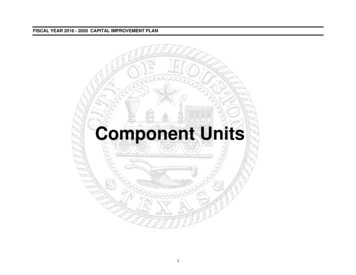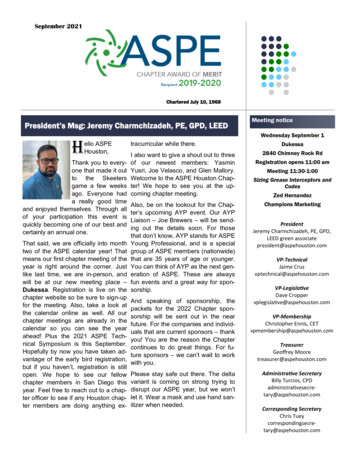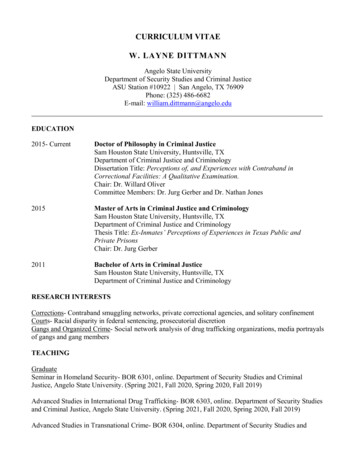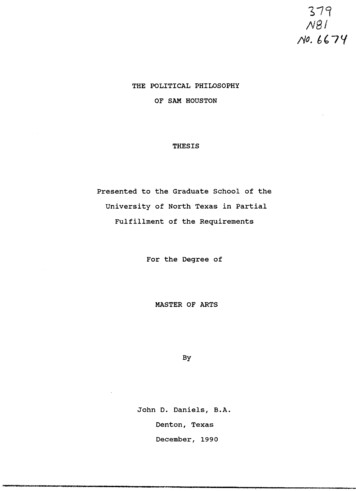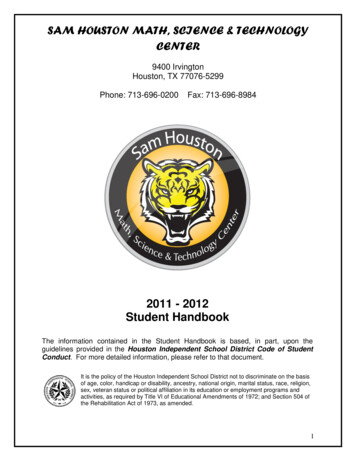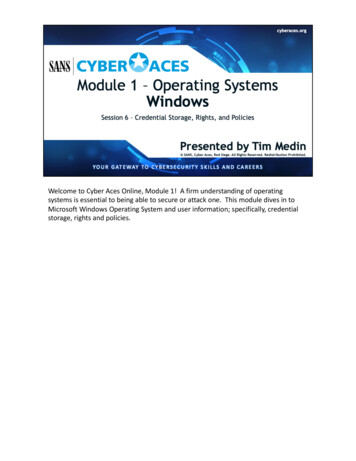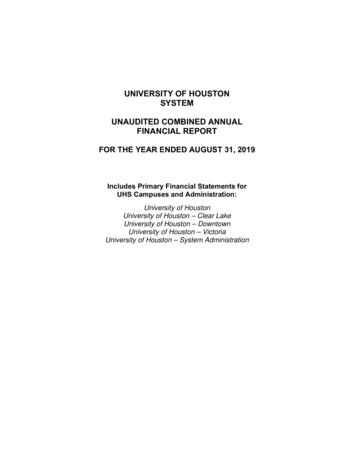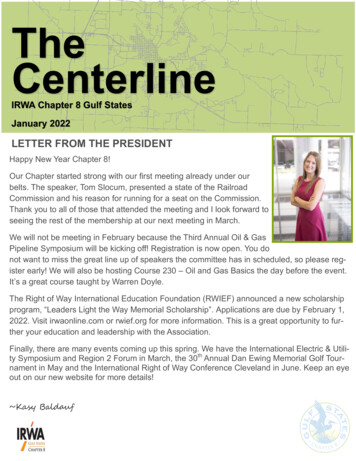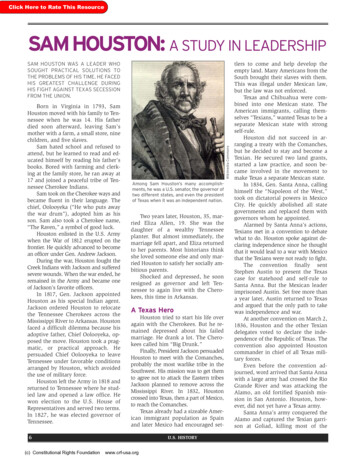
Transcription
Click Here to Rate This ResourceSAM HOUSTON: A STUDY IN LEADERSHIPBorn in Virginia in 1793, SamHouston moved with his family to Tennessee when he was 14. His fatherdied soon afterward, leaving Sam’smother with a farm, a small store, ninechildren, and five slaves.Sam hated school and refused toattend, but he learned to read and educated himself by reading his father’sbooks. Bored with farming and clerking at the family store, he ran away at17 and joined a peaceful tribe of Tennessee Cherokee Indians.Sam took on the Cherokee ways andbecame fluent in their language. Thechief, Oolooyeka (“He who puts awaythe war drum”), adopted him as hisson. Sam also took a Cherokee name,“The Raven,” a symbol of good luck.Houston enlisted in the U.S. Armywhen the War of 1812 erupted on thefrontier. He quickly advanced to becomean officer under Gen. Andrew Jackson.During the war, Houston fought theCreek Indians with Jackson and sufferedsevere wounds. When the war ended, heremained in the Army and became oneof Jackson’s favorite officers.In 1817, Gen. Jackson appointedHouston as his special Indian agent.Jackson ordered Houston to relocatethe Tennessee Cherokees across theMississippi River to Arkansas. Houstonfaced a difficult dilemma because hisadoptive father, Chief Oolooyeka, opposed the move. Houston took a pragmatic, or practical approach. Hepersuaded Chief Oolooyeka to leaveTennessee under favorable conditionsarranged by Houston, which avoidedthe use of military force.Houston left the Army in 1818 andreturned to Tennessee where he studied law and opened a law office. Hewon election to the U.S. House ofRepresentatives and served two terms.In 1827, he was elected governor ofTennessee.Wikimedia CommonsSAM HOUSTON WAS A LEADER WHOSOUGHT PRACTICAL SOLUTIONS TOTHE PROBLEMS OF HIS TIME. HE FACEDHIS GREATEST CHALLENGE DURINGHIS FIGHT AGAINST TEXAS SECESSIONFROM THE UNION.Among Sam Houston’s many accomplishments, he was a U.S. senator, the governor oftwo different states, and even the presidentof Texas when it was an independent nation.Two years later, Houston, 35, married Eliza Allen, 19. She was thedaughter of a wealthy Tennesseeplanter. But almost immediately, themarriage fell apart, and Eliza returnedto her parents. Most historians thinkshe loved someone else and only married Houston to satisfy her socially ambitious parents.Shocked and depressed, he soonresigned as governor and left Tennessee to again live with the Cherokees, this time in Arkansas.A Texas HeroHouston tried to start his life overagain with the Cherokees. But he remained depressed about his failedmarriage. He drank a lot. The Cherokees called him “Big Drunk.”Finally, President Jackson persuadedHouston to meet with the Comanches,probably the most warlike tribe in theSouthwest. His mission was to get themto agree not to attack the Eastern tribesJackson planned to remove across theMississippi River. In 1832, Houstoncrossed into Texas, then a part of Mexico,to reach the Comanches.Texas already had a sizeable American immigrant population as Spainand later Mexico had encouraged set-6(c) Constitutional Rights FoundationU.S. HISTORYwww.crf-usa.orgtlers to come and help develop theempty land. Many Americans from theSouth brought their slaves with them.This was illegal under Mexican law,but the law was not enforced.Texas and Chihuahua were combined into one Mexican state. TheAmerican immigrants, calling themselves “Texians,” wanted Texas to be aseparate Mexican state with strongself-rule.Houston did not succeed in arranging a treaty with the Comanches,but he decided to stay and become aTexian. He secured two land grants,started a law practice, and soon became involved in the movement tomake Texas a separate Mexican state.In 1834, Gen. Santa Anna, callinghimself the “Napoleon of the West,”took on dictatorial powers in MexicoCity. He quickly abolished all stategovernments and replaced them withgovernors whom he appointed.Alarmed by Santa Anna’s actions,Texians met in a convention to debatewhat to do. Houston spoke against declaring independence since he thoughtthat it would lead to a war with Mexicothat the Texians were not ready to fight.The convention finally sentStephen Austin to present the Texascase for statehood and self-rule toSanta Anna. But the Mexican leaderimprisoned Austin. Set free more thana year later, Austin returned to Texasand argued that the only path to takewas independence and war.At another convention on March 2,1836, Houston and the other Texiandelegates voted to declare the independence of the Republic of Texas. Theconvention also appointed Houstoncommander in chief of all Texas military forces.Even before the convention adjourned, word arrived that Santa Annawith a large army had crossed the RioGrande River and was attacking theAlamo, an old fortified Spanish mission in San Antonio. Houston, however, did not yet have a Texas army.Santa Anna’s army conquered theAlamo and captured the Texian garrison at Goliad, killing most of the
Wikimedia CommonsA painting depicts Santa Anna surrendering to the wounded Sam Houston after the Battle of San Jacinto, 1836.soldiers who had surrendered. SantaAnna then organized an attack acrossTexas to crush the rebellion. Houstonquickly assembled volunteers for theTexas army, but needed time to trainthem and the right opportunity to attack. Buying time, he retreated fromSanta Anna’s invading army, causingmany to call him a coward.Finally, an overconfident SantaAnna led an advance unit of his muchlarger army closer to Houston andcamped at San Jacinto. This was theopportunity Houston wanted.On April 21, 1836, Houston onhorseback led the Texians together witha unit of Tejanos (Texas Mexicans) in asurprise attack on Santa Anna’s camp.Houston’s fighters, yelling “Rememberthe Alamo,“ slaughtered the Mexicansoldiers. Most important, they capturedthe “Napoleon of the West“ himself. Inexchange for his life, Santa Anna signedan agreement sending the rest of hisarmy back to Mexico.Houston was badly wounded inthe ankle. But his strategy of waitingfor the right moment to attack madehim a Texas hero.President HoustonIn September 1836, Houston wasoverwhelmingly elected the first president of the Republic of Texas. He servedtwo terms as president separated by aterm in the Texas Congress.Houston released Santa Anna afterthe dictator promised to recognizeTexas independence. Once in MexicoCity, however, he broke his promise,claiming Texas was still part of Mexico.Houston opposed schemes byTexas hot heads to invade Mexico andoccupy territory south of the RioGrande. Invading Mexico was notpractical, he said, because “We haveno money!”As president of Texas, Houstontook a number of unpopular stances.He condemned the brutal treatment ofCherokees and other peaceful Texastribes by white vigilantes. To settle differences between Indians and whites,he negotiated just treaties. He also refused to enforce a law that gave freeblacks two years to leave Texas or bere-enslaved.In between his two terms as president, Houston finally divorced his firstwife, still living in Tennessee. In 1840at age 47, he married 21-year-old Margaret Lea from Alabama. During theirmarriage, they lived in various housesand farms with a dozen slaves. Shegave birth to eight children. She alsosobered him up.From the beginning of his presidency, Houston strongly pushed forannexing Texas to the U.S. He realizedthat the republic had little hope of defending itself against hostile foreignpowers. After some stalling, the U.S.Congress voted to annex Texas to theUnion in 1845.Texas citizens voted for annexationin a referendum by an overwhelmingmajority. The new Texas state legislature elected Houston as one of its twoU.S. senators. (The direct election ofU.S. HISTORY(c) Constitutional Rights Foundationwww.crf-usa.orgU.S. senators by the voters did notoccur until 1913.)Senator HoustonSen. Sam Houston, who declaredhimself a Democrat, first arrived inWashington in early 1846. He was immediately involved in Senate debateson war with Mexico. Santa Anna disputed the new international boundarywith the U.S., following its annexationof Texas. After clashes between Mexican and American troops, Santa Annadeclared war on the U.S.President Polk urged Congress to declare war on Mexico, which it did withHouston’s full support in May 1846.Many Southerners favored the war because the U.S. would likely acquire newwestern territories that would enable theexpansion of slavery and admission ofnew slave states.Houston’s upbringing in the Southinfluenced his beliefs about slavery. Hedefended slavery and believed thatwhites were superior to blacks. But heonce said that Indians and black slaveswere equally intelligent. The differencebetween them, he explained, was thatIndians were born free and raised to beself-reliant, while black slaves wereborn as property with their lives forever controlled by their owners.Unlike most Southern slave owners, Houston allowed his own slaves tolearn to read, write, and do arithmetic.They could also keep any money theyearned when they worked for others.Houston believed that suddenlyabolishing slavery would ruin the7
Wikimedia CommonsThe Compromise of 1850economy of the South and result inlarge numbers of former slaves “castinto the streets,” unemployed and impoverished. He believed it was better forthe North and South to work on a compromise, perhaps by sponsoring the return of freed slaves to a colony in Africa.After the war with Mexico, the question of slavery in the newly acquiredlands in the West became heated in theSenate. Houston criticized both theNorthern abolitionists for their “mad fanaticism” and the Southern extremists fortheir “mad ambition.”South Carolina’s Sen. John C. Calhoun threatened secession from theUnion unless slavery was permitted inOregon and the Mexican Cession territories. Houston argued that the climate andnature of agriculture in the West did notmake plantation slave labor practical.The Compromise of 1850 admittedCalifornia as a free state but required thatslaves who had escaped to the North bereturned to their owners. Many Southerners fought against the compromisesince it did not guarantee the right to ownslaves in all the Western territories. Houston voted for the compromise.Three years later, Sen. Stephen Douglas, a Democrat from Illinois, proposedthe Kansas-Nebraska Act. This wouldleave it up to the people of these new territories to vote whether they wanted slavery or not. The act would repeal that partthe 1820 Missouri Compromise that prohibited slavery north the 36 30’ line oflatitude from the Mississippi to the Pacific.Southern slaveholders supported theKansas-Nebraska Act because it openedthe door to expanding slavery into theWest. Northern abolitionists hated it.Houston feared the repeal of the MissouriCompromise would threaten the protection of slavery in Southern states south ofthe 36 30’ line.In 1854, Congress passed theKansas-Nebraska Act. Houston votedagainst it and was viciously attacked asa traitor to the South.Fight Against SecessionIn 1859, Houston ran for governorof Texas. He campaigned against extremists who favored secession fromthe Union and reopening the Africanslave trade (banned by Congress in1808). Secession, he warned, wouldonly lead to a civil war the South couldnot win. He argued that the best wayto resolve the slavery issue was bycompromise within the Union.Houston criticizedboth the Northernabolitionists for their‘mad fanaticism’ and theSouthern extremists fortheir ‘mad ambition.’Houston’s moderate and pragmaticpositions on the slavery issue helpedhim win the governorship of Texas. Buta few months later, John Brown raidedthe federal armory at Harper’s Ferry,Virginia, and threatened to arm a slaverebellion. Most Texans now believedthat the intention of the Northern abo-8(c) Constitutional Rights FoundationU.S. HISTORYwww.crf-usa.orglitionists was to destroy the Southerneconomy and way of life. From thenon, the secessionists had the upperhand in Texas.In the crucial presidential electionof 1860, the dominant DemocraticParty split apart. Northerners supported Stephen Douglas, who ran onhis idea of letting the voters decide theslavery issue in the Western territories.Southern Democrats nominated theirown candidate, who called for secession from the Union unless slavery waspermitted in the Western territories.The Republican Party nominatedAbraham Lincoln, who opposed thespread of slavery. Lincoln was not anabolitionist, but most Southerners distrusted him.Other candidates, including SamHouston, entered the presidentialrace. Although officially a Democrat,Houston despised the secretive politics at party nominating conventions.He preferred to be thrust up for election by the people themselves. Agroup of Texas supporters gathered atthe San Jacinto battlefield and votedto nominate him for president. Heagreed to run. Surprisingly, Houstonhad supporters in the North, especially in New York.A few months later, thinking he hadno chance for election, he withdrew hisname as a candidate. He spent the rest ofthe campaign pleading to keep the Uniontogether (see sidebar on page 9).Lincoln’s election on November 6,1860 ignited the secession movement inTexas and the rest of the South. A monthlater, South Carolina was the first to secede from the Union.The Texas state legislature was notin session, and it alone could authorizea secession convention. Houston stalledand refused to call a special session ofthe legislature, hoping delay would calmthings down. But in January 1861, hebrought the legislature back to Austin,the state capital. He tried to persuadethe state legislators to hold off authorizing a convention, but they voted overwhelmingly for it.The convention met quickly andvoted almost unanimously to approveleaving the Union. Then in a referendum, 75 percent of Texas voters approvedsecession. Even most non-slaveholders
seemed to believe that only by seceding from the Union could they maintain their economic well-being.Houston accepted the will of thepeople, but challenged the conventionwhen it voted for Texas to join the Confederacy. He argued neither the legislature nor the voters had called for thataction. But the convention ignoredhim. It ordered all state officials to takean oath of allegiance to the Confederacy, but Houston refused. The convention then removed him from office.The convention made it clear thatHouston was no longer welcome inAustin. His friends tried to persuadehim to use armed force to remain asgovernor. Even Lincoln sent messages, offering him aid. But Houstonrejected the idea of starting a civil warwithin Texas.Houston left Austin with his family. A few days later, he said to a crowdof Union supporters:The civil war is now near at handand will be stubborn and of long duration. . . . The soil of our belovedSouth will drink deep the preciousblood of our sons and brethren.’Texas! Texas! Margaret‘Houston reluctantly supportedTexas in the Civil War. His oldest son,Sam Jr., joined a Texas volunteer infantry unit and was severelywounded at the Battle of Shiloh.In September 1862, Lincoln issued his preliminary EmancipationProclamation. Freeing one’s ownslaves was illegal in Texas. But Houston gathered his dozen slaves at hishome, read Lincoln’s proclamationto them, and declared them free.In his last days, Houston still plotted to rescue Texas from the disasterof defeat. He wanted Texas to secedefrom the Confederacy and become anindependent republic again with himself as its leader. “The people willuphold me in this,” he said, “andSam Houston’s Speech at a Mass Meetingfor Preserving the UnionAustin, Texas September 22, 1860In this excerpt, Houston gave his reasons for Texas remaining in the Union.Power, wealth, expansion, victory, have followed [the American people], and yet the. . . Union has been broad enough to [include] all. Is it not worth perpetuating? Willyou exchange this for all the hazards, the anarchy and carnage of civil war? Do youbelieve it will be [divided] and no shock felt by society? You are asked to plunge intoa revolution; but are you told how to get out of it? Not so. . . .What is there that is free that we have not? Are our rights invaded and no Government ready to protect them? No! Are our institutions wrested from us and othersforeign to our taste forced upon us? No! Is the right of free speech, a free press, orfree suffrage taken from us? No! Has our property been taken from us and the Government failed to interpose when called upon? No! No, none of these!. . .I come not here to speak in behalf of a united South against Lincoln, I appeal to thenation. I ask not the defeat of sectionalism by sectionalism, but by nationality. TheUnion is worth more than Mr. Lincoln, and if the battle is to be fought for theConstitution, let us fight it in the Union and for the sake of the Union.1.In the first paragraph, why does Houston believe preserving the Union is betterthan disunion?2. In the second paragraph, what overall point does Houston seem to be makingwith his series of questions?3. In the last paragraph, what method does Houston propose to resolve the issuesthat divided the North and South?with God’s help we will save Texas.”Nothing came of his idea: Texas remained in the Confederacy.Houston’s health declined rapidly, partly due to wounds from theWar of 1812 that never healed properly. His last words to his wife as helay dying were, “Texas! Texas! Margaret.” He died of pneumonia at age70 on July 26, 1863 only days afterthe decisive Union victories at Vicksburg and Gettysburg.1. Do you think Sam Houston’s experience with the Cherokees influencedhis career as a leader? Explain.2. What evidence is there that SamHouston was neither an anti-slavery abolitionist nor a pro-slaveryextremist?3. Do you think Sam Houston as apragmatic leader was a success ora failure? Why?ACTIVITYA Better Choice for President?1. Based on the information in the article, each student should write anessay on this question: Knowing now what happened after Lincolnwas elected, do you think Sam Houston would have made a betterchoice for president in 1860?2. The students will then meet in small groups and hold a collaborativediscussion on the question, trying to reach consensus if possible.3. Each group will finally report and give the reasons for the results ofits tiontwitter.com/crfusaU.S. HISTORY(c) Constitutional Rights FoundationDISCUSSION & WRITINGwww.crf-usa.orgplus.google.com/ Crf-usaOrg/posts9
SourcesJoan of ArcBrooks, P. Beyond the Myth: The Story of Joan of Arc. Boston: Houghton Mifflin, 1990. Hobbins, D. trans. The Trial of Joan of Arc. Cambridge, Mass.: Harvard UP, 2005. "Hundred Years War." Wikipedia. 30 June 2014. URL:http://en.wikipedia.org Pernoud, R. et al. Joan of "rc: Her Story. NY: St. Martin's P, 1998. Richey, S. Joan of Arc: The Warrior Saint. Westport, Conn.:Praeger, 2003. Seward, D. The Hundred Years War: The English in France13371453. NY: Atheneum, 1978. Taylor, L. The Virgin Warrior: The Life andDeath of Joan of "rc. New Haven, Conn.: Yale UP, 2009.Sam HoustonBaum, D. The Shattering of Texas Unionism: Politics in the Lone Star State During the Civil War Era. Baton Rouge, La.: Louisiana State UP, 1998. Campbell,R. Sam Houston and the "merican Southwest. 2nd ed. NY: Longman, 2002.Haley, J. Sam Houston. Norman, Okla.: U of Oklahoma P, 2002. James, M.The Raven: " Biography of Sam Houston. Indianapolis, Ind.: Bobbs-Merrill,1929. Jewett, C. Texas in the Confederacy. U of Missouri P, 2002.Margaret Thatcher1974: Miners' Strike Comes to an End." BBC News. 3 June 1974. URL:http://news.bbc.co.uk "1978: Callaghan Accused of Running Scared." BBCNews. 9 July 1978. URL: http://news.bbc.co.uk Anderson, D. "Falklands WarTwenty Years On. (Frontline)." History Today. Mar. 2002. Black, G. "The TinaSyndrome: Is There Life after Thatcher?" Nation 8 May 1989. Blundell, J. Margaret Thatcher: " Portrait of the Iron Lady. NY: Algora Pub., 2008. Evans, E.Thatcher and Thatcherism. 2nd ed. London: Routledge, 2004. Geelhoed, E. etal. Margaret Thatcher: In Victory and Downfall, 1987 and 1990. NY: Praeger,1992. Harper, K. "Pit Strike Ends in Defiance and Tears." The Guardian 4 Mar.1985. URL: www.theguardian.com Rogers, C. "From Union Legislation to Financial Reform: " Reflection on Thatcherism, Capital and the British State."Capital & Class 38.2, 2014. Segell, G. "Prime Minister Mrs. Margaret Thatcher"dvancing Gender Equality: Recruitment, Roles, Pay, and Pensions in theArmed Forces." "dvancing Women in Leadership 24 (2007). Seymour, R. "AShort History of Privatisation in the UK: 19792012." The Guardian, 29 Mar.2012. URL: www.theguardian.com Sullivan, ". "Thatcher, Liberator." The Dish.8 "pr. 2013. URL: http://dish.andrewsullivan.com Taylor, ". "MargaretThatcher Fought One Huge Battle That Changed The UK Forever." Business Insider. 2013. URL: www.businessinsider.com Thatcher, M. "Remarks on Orgreave picketing." 30 May 1984. Margaret Thatcher Foundation. URL:www.margaretthatcher.org . "Speech to Conservative Party Conference." 10Oct. 1986. Margaret Thatcher Foundation. URL: www.margaretthatcher.orgTrickett, J. "Can Labour Learn from Thatcher and Turn the Wheel of History?"New Statesman. 13 Mar. 2014. URL: www.newstatesman.com Welch, M."How Thatcher Defeated Mitterrand: Lessons from the Late Prime Minister'sDecisive Victory in the War of Economic Ideas." Reason. June 2013. Wilenius,P. "Enemies Within: Thatcher and the Unions." BBC News. 3 May 2004. URL:http://news.bbc.co.uk Young, C. "How Margaret Thatcher Advanced Women'sLiberation." Reason Foundation, 20 "pr. 2013. URL: http://reason.com Young,H. One of Us. London: Pan, 2013.StandardsJoan of ArcNational High School World History Standard 23: Understands patterns of crisis andrecovery in Afro-Eurasia between 1300 and 1450. (9) Understands the significanceWar, including territorial settlements, the aftermath of the wars, and the effects the wars had on the lives of Americans. . . .of Joan of Arc (e.g., her role in the Hundred Years War, her subsequent trial andexecution, the Church's review of her trial 25 years later, and her revered imageas a patron saint of France).California History-Social Science Standard 8.9: Students analyze the early and steadyattempts to abolish slavery and to realize the ideals of the Declaration of Independence. (4) Discuss the importance of the slavery issue as raised by the annexa-California History-Social Science Standard 7.6: Students analyze the geographic, political, economic, religious, and social structures of the civilizations of Medieval Europe.(3) Understand the development of feudalism, its role in the medieval Europeaneconomy, the way in which it was influenced by physical geography (the roleof the manor and the growth of towns), and how feudal relationships providedthe foundation of political order. (8) Understand the importance of the Catholicchurch as a political, intellectual, and aesthetic institution (e.g. founding ofuniversities, political and spiritual roles of the clergy. . . .).Common Core Standard RH.6-8.1 and RH.9-10.1: Cite specific textual evidence to support analysis of primary and secondary sources.Common Core Standard RI.7.8: Trace and evaluate the argument and specific claimsin a text, assessing whether the reasoning is sound and the evidence is relevant andsufficient to support the claims.Common Core Standard RI.9-10.8: Delineate and evaluate the argument and specificclaims in a text, assessing whether the reasoning is valid and the evidence is relevant and sufficient; identify false statements and fallacious reasoning.Sam HoustonNational High School U.S. History Standard 9: Understands the United States territorial expansion between 1801 and 1861, and how it affected relations with externalpowers and Native Americans. (3) Understands shifts in federal and state policytoward Native Americans in the first half of the 19th century (e.g., argumentsfor and against removal policy, changing policies from assimilation to removaland isolation after 1825). (6) Understands Mexican and American perspectivesof events leading up to the Mexican-American War (e.g., the Alamo, the treatment of Mexicans and Cherokees loyal to the Texas Revolution in the Lone StarRepublic prior to 1846).National High School U.S. History Standard 11: Understands the extension, restriction,and reorganization of political democracy after 1800. (2) Understands the positionsof northern antislavery advocates and southern proslavery spokesmen on a variety of issues (e.g., race, chattel slavery, the nature of the Union, states' rights).National High School U.S. History Standard 13: Understands the causes of the CivilWar. (2) Understands events that fueled the political and sectional conflict overslavery and ultimately polarized the North and the South (e.g., the Missouri Compromise, the Wilmot Proviso, the Kansas-Nebraska Act)California History-Social Science Standard 8.7: Students analyze the divergent paths ofthe American people in the South from 1800 to the mid-1800s and the challenges theyfaced. (2) Trace the development of slavery; its effects on black Americans and onthe region's political, social, religious, economic, and cultural development; andidentify the strategies that were tried to both overturn and preserve it. . . .California History-Social Science Standard 8.8: Students analyze the divergent pathsof American people in the West from 1800 to the mid-1800s and the challenges theyfaced. (6) Describe the Texas War for Independence and the Mexican-American(c) Constitutional Rights Foundationwww.crf-usa.orgtion of Texas and California's admission to the union as a free state under theCompromise of 1850. (5) Analyze the significance of the States' Rights Doctrine. . . , the Compromise of 1850, the Kansas-Nebraska Act (1854). . . .California History-Social Science Standard 8.10: Students analyze the multiple causes,key events, and complex consequences of the Civil War. (3) Identify the Constitu-tional issues posed by the doctrine of nullification and secession. . . .Common Core Standard WHST.6-8.1 and 11-12.1: Write arguments focused on disciplinespecific content. . . .Common Core Standard RH.6-8.2 and 11-12.2: Determine the central ideas or information of a primary or secondary source. . . .Common Core Standard SL.11-12.1: Initiate and participate effectively in a range of collaborative discussions (one-on-one, in groups, and teacher led) with diverse partnerson grades 11-12 topics, texts, and issues, building on others' ideas and expressing theirown clearly and persuasively.Margaret ThatcherNational High School Civics Standard 5: Understands the major characteristics ofsystems of shared powers and of parliamentary systems. (2) Understands the majorcharacteristics of parliamentary systems . . . . (3) Understands the relative advantages and disadvantages of the various ways power is distributed, shared,and limited in systems of shared powers and parliamentary systems . . . .California History-Social Science Standard 12.9: Students analyze the origins, characteristics, and development of different political systems across time, with emphasis on the quest for political democracy, its advances, and its obstacles. (2) Comparethe various ways in which power is distributed, shared, and limited in systemsof shared powers and in parliamentary systems, including the influence androle of parliamentary leaders (e.g., William Gladstone, Margaret Thatcher).Common Core Standard RH.1112.3: Evaluate various explanations for actions or eventsand determine which explanation best accords with textual evidence, acknowledgingwhere the text leaves matters uncertain.Common Core Standard RH.1112.6: Evaluate authors' differing points of view on the samehistorical event or issue by assessing the authors' claims, reasoning, and evidence.Common Core Standard SL.1112.4: Present information, findings, and supporting evidence, conveying a clear and distinct perspective, such that listeners can follow theline of reasoning, alternative or opposing perspectives are addressed, and the organization, development, substance, and style are appropriate to purpose, audience,and a range of formal and informal tasks.Standards reprinted with permission:National Standards 2000 McREL, Mid-continent Research for Education andLearning, 2550 S. Parker Road, Ste. 500, Aurora, CO 80014, (303)337.0990.California Standards copyrighted by the California Dept. of Education, P.O. Box271, Sacramento, CA 95812.
majority. The new Texas state legisla-ture elected Houston as one of its two U.S. senators. (The direct election of U.S. senators by the voters did not occur until 1913.) Senator Houston Sen. Sam Houston, who declared himself a Democrat, first arrived in Washington in early 1846. He was im-mediately involved in Senate debates on war with Mexico.
